Length 17 m First flight August 20, 1970 | Introduced 1975 Manufacturer Mikoyan | |
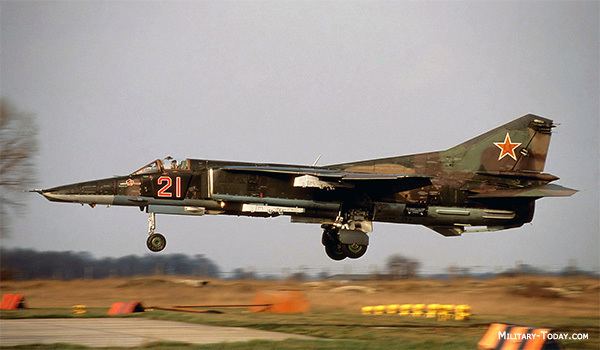 | ||
The Mikoyan MiG-27 (Russian: Микоян МиГ-27; NATO reporting name "Flogger-D/J") is a variable-geometry ground-attack aircraft, originally built by the Mikoyan design bureau in the Soviet Union and later license-produced in India by Hindustan Aeronautics as the Bahadur ("Valiant"). It is based on the Mikoyan-Gurevich MiG-23 fighter aircraft, but optimized for air-to-ground attack. Unlike the MiG-23, the MiG-27 did not see widespread use outside Russia, as most countries opted for the MiG-23BN and Sukhoi Su-22 instead. It remains in service with the Indian, Kazakh and Sri Lankan Air Forces in the ground attack role. All Russian and Ukrainian MiG-27s have been retired.
Contents
- Mikoyan mig 27 flogger
- Design and development
- Operational history
- Sri Lanka
- India
- Kazakhstan
- Variants
- Operators
- Specifications MiG 27K
- References
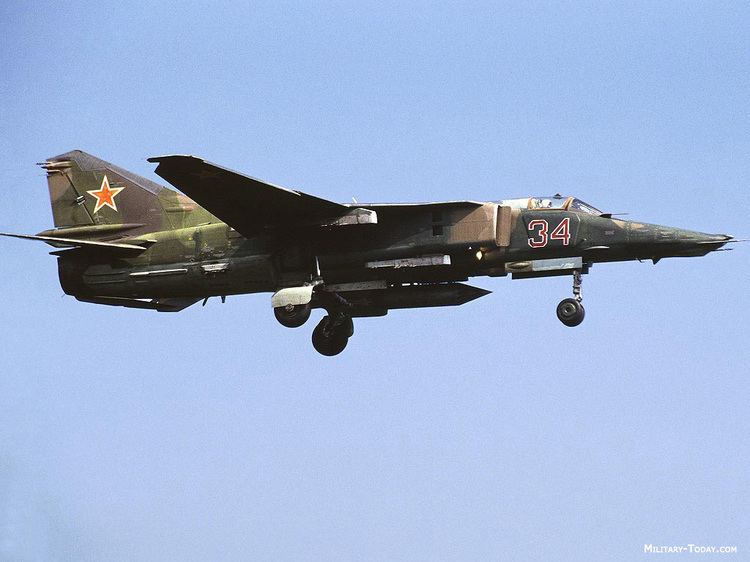
Mikoyan mig 27 flogger
Design and development

The MiG-27 shares the basic airframe of the MiG-23, but with a revised nose – nicknamed "Utkonos" ("Platypus") in Russian service, first introduced on the MiG-23B. Dissatisfaction with the MiG-23BN led to the further development of the basic airframe to accommodate a stronger undercarriage, simpler intakes and a shorter exhaust nozzle, without radar in favor of a downward-sloping profile for improved pilot visibility, a laser rangefinder and marked-target seeker. Among its test pilots, it was also called "Balkon" ("Balcony") because of the increased frontal view from the cockpit. Additional cockpit armor was installed, along with a totally new nav/attack system.
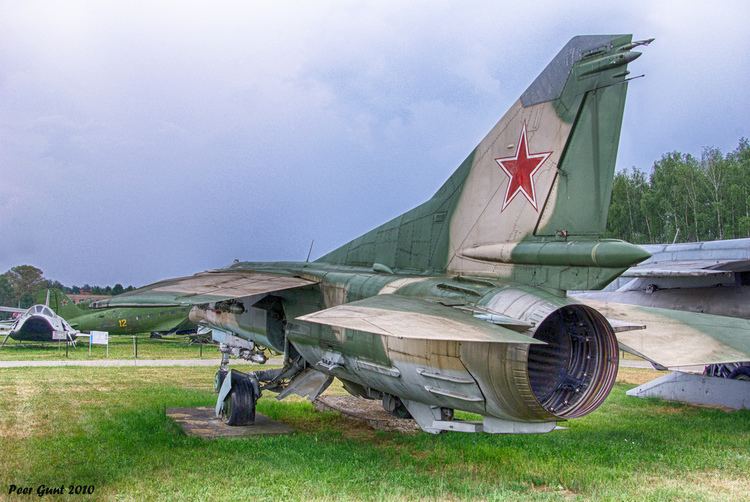
Since the MiG-27 was intended to fly most of its missions at low altitude, the MiG-23's variable intake ramps and exhaust nozzles were discarded in favor of a simpler fixed configuration, reducing weight and maintenance requirements. The aircraft also has larger, heavy-duty landing gear to facilitate operation from poorer-quality airfields. In accordance with the MiG-27s strike and low-level attack requirements, provisions were made to mount missiles and precision-guided munitions, as well as retaining a nuclear capability in line with other Soviet combat aircraft by introducing specialized navigation systems.
Operational history
It was used by Soviet forces during the later stages of the Afghanistan conflict in 1987–89.
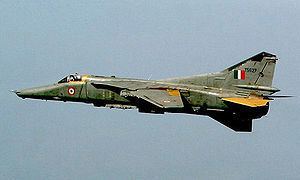
Although several Western observers considered the MiG-27 widely exported, confusing it with the MiG-23BN, the aircraft type was only exported to India and Sri Lanka which also utilized the MiG-27 in regional conflicts.
Sri Lanka
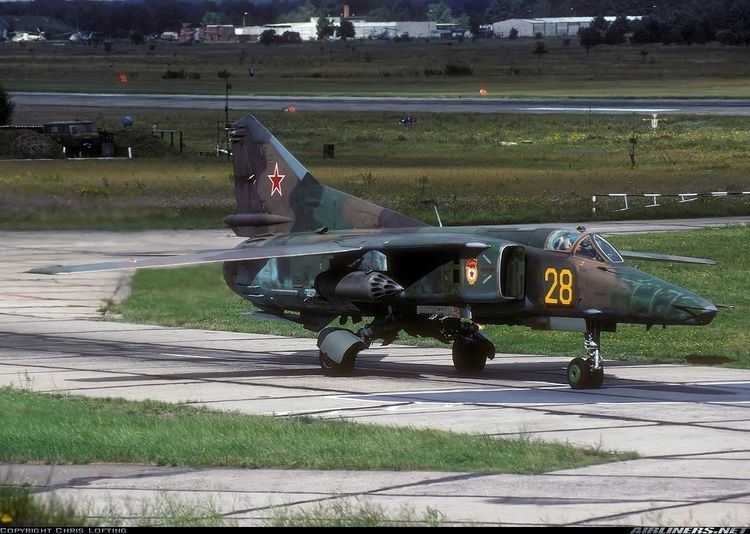
MiG-27 aircraft entered service with the Sri Lanka Air Force in 2000. During the Sri Lankan Civil War, they saw considerable action bombing targets and providing close air support. In August 2000, a MiG-27 crashed near Colombo International Airport, killing its Ukrainian pilot. In July 2001, a second MiG-27 was destroyed and another damaged on the ground during an assault on the same air force base by the Liberation Tigers of Tamil Eelam. A MiG-27 crashed into the sea near the airport in June 2004. Another MiG-27 fighter jet crashed on a routine training mission on 13 February 2012 near the Dummalasuriya area at around 1.35 pm. The pilot managed to eject from the jet without sustaining injuries.
India
On 27 May 1999, during the Kargil War, one Indian MiG-27 was lost together with a MiG-21 while supporting an Indian ground offensive in the Kashmir region.
Since 2001, the Indian Air Force has lost more than 12 MiG-27s to crashes. In mid-February 2010, India grounded its entire fleet of over 150 of the aircraft after a MiG-27 crashed on 16 February 2010 in Siliguri, West Bengal. The crash was attributed to defects in the R 29 engines of the aircraft, suspected to have occurred during the overhauling of the aircraft by Hindustan Aeronautics Limited (HAL). Another Mig-27 crashed in the Barmer area on 27 January 2015.
On 13 June 2016, a MiG-27 (TU 657) on a training mission crashed in a residential area near Jodhpur Airforce Base in Rajasthan damaging two houses and injuring three civilians while the pilot(s) ejected safely. The aircraft appears to be an Indian upgraded variant of MiG-27.
Kazakhstan
The MiG-27 remains in service with the Kazakh Air Force.
Variants
The first Flogger attack variant was powered by the AL-21F. Only 24 were produced, due a lack of engines (the AL-21F was destined for the Sukhoi Su-17/22 and the Su-24 Fencer). It was armed with the GSh-23L cannon, carrying 200 rounds.
Derived from the MiG-23B, but powered by the R29B-300 engine. This gave the advantage of making this variant exportable (the AL-21F was a restricted engine at the time, unlike the R29B-300). The R29B-300 also offered commonality with the MiG-23MS and MiG-23MF fighter variants already sold to the rest of world. It was armed with the GSh-23L cannon, with 200 rounds.
This was the first in the MiG-27 family to have a canopy without the central frame, suggesting that the ejection seat was designed to directly break through the transparency. The dielectric head above the pylon on the MiG-23 was used on the MiG-27 to house electro-optical and radio-frequency gear instead. It was also the first variant armed with a Gryazev-Shipunov GSh-6-30M Gatling gun. Its NATO reporting name was Flogger-D.
NATO reporting name: Flogger-J2. The MiG-27K was most advanced Soviet variant, with a laser designator and compatibility with TV-guided electro-optical weapons. It carried the GSh-6-30 cannon. Around 200 were built.
NATO reporting name: Flogger-J. This model was a cheaper variant than the MiG-27K, but much better than the MiG-23B, MiG-23BN, and MiG-27 (MiG-23BM), with the electro-optical and radio-frequency heads above the glove pylons deleted. It was first armed with the GSh-6-23M Gatling gun, but this was later replaced by a new 30 mm GSh-6-30 six-barrel cannon with 260 rounds of ammunition in a fuselage gondola. It also received much-improved electronic countermeasure (ECM) systems, and a new PrNK-23K nav/attack system providing automatic flight control, gun firing, and weapons release. However, this modification was not very successful because of the heavy recoil from the new cannon, and bursts longer than two or three seconds often led to permanent damage to the airframe. Test pilot V. N. Kondaurov described the first firing of the GSh-6-30А: "As I imposed the central mark on the air target and pressed the trigger to shoot, I heard such noise that I involuntarily drew my hand aside. The whole plane began to vibrate from the shooting and had almost stopped from the strong recoil of the gun. The pilotless target, which was just making a turn ahead of me, was literally disintegrating into pieces. I have hardly come to my senses from unexpectedness and admiration: This is a calibre! Such a beast! If you hit something — it will be plenty enough [to wipe it out]". A total of 200 MiG-27Ms were built from 1978 to 1983, plus 160 for India, and it is currently in service with the Sri Lanka Air Force.
All MiG-27D are MiG-27s (MiG-23BMs) upgraded to MiG-27M standard. It is very difficult to distinguish from the MiG-27M. 305 were upgraded.
This was an export variant of the MiG-27M provided in 1986 to India in knock-down kits for license-assembly. It was the same as the MiG-27M, except the undernose fairing for the infra-red search and track (IRST) sensor had a single window instead of several, like the one on the original MiG-27M. A total of 150 were assembled by India. India refers to this model as the MiG-27M Bahadur, while MiG-27L is the Mikoyan export designation.
This was a 1988 indigenous Indian upgrade of its license-assembled MiG-27L with French avionics, which provides the same level of performance, but with much reduced size and weight. The capabilities of the aircraft are being enhanced by the incorporation of modern avionics systems consisting primarily of two Multi-Function Displays (MFDs) Mission and Display Processor (MDP), Sextant Ring Laser Gyros (RLG INSI), combined GPS/GLONASS navigation, HUD with UFCP, Digital Map Generator (DMG), jam-resistant Secured Communication, stand-by UHF communication, data link and a comprehensive Electronic Warfare (EW) Suite. A mission planning and retrieval facility, VTR and HUD Camera will also be fitted. The aircraft retains stand-by (conventional) instrumentation, including artificial horizon, altimeter and airspeed indicator, to cater for the failure of HUD and the MFDs. The MiG-27s are also being equipped with the French Agave or Russian Komar radar. The installation of the radar would give the MiG-27 anti-ship and some air-to-air capability. It is expected that at least 140 of the 180 aircraft will be converted from MiG-27MLs.
Operators
Specifications (MiG-27K)
Data from
General characteristics
Performance
Armament
